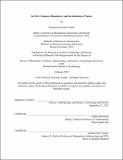| dc.description.abstract | This anthropological study of biomimicry examines how nature has been imagined and mobilized by American management consultants at the dawn of 21st century. Whereas culture has been invested with economic potential in “human-centered design,” consultants who name themselves “biomimics” valorize nature, specifically “life,” as a site of technological innovation. In their folk epistemology of biology, 3.8 billion years of evolution have designed “adaptations” to the environment that are superior to human artifice: more powerful, more efficient, and more sustainable. Following the author-turned-consultant Janine Benyus, an ecosystem of innovation consultancies has arisen around the orthodoxy that the imitation of biological “design principles” would generate “sustainable innovation.” Despite their promise, however, little has materialized.
Based on six years of ethnographic fieldwork in North America, with an emphasis on the United States, I analyze how biomimics construe, produce, and evaluate imitations to understand the cultural dimensions of this gap between vision and circumstance. Drawing on interviews with over forty biomimics and participant observation at consulting workshops, design competitions, and related public events, I document how consultants appraise the fidelity between originals and copies, life and design. While biomimics aspire toward artifacts that truthfully resemble nature, I demonstrate that, in practice, the meaning of resemblance—i.e. of life’s likeness—is multiple and situated. Specifically, I discern three mimetic stances: the pragmatic, idealistic, & performative. I argue that this dissensus around valid imitations betrays the subsumption of biomimicry, and green design in general, by capitalist profit logics. In conversation with anthropologists of nature, design, & imitation, I show how the “bio” in biomimicry, or the “nature” in nature-based design, has become a capacious term that consultants manipulate to justify the status quo. Biomimicry, I reflect, exposes contemporary tensions of pragmatism/utopia, capital/ecology, and ethics/design.
In biomimicry, “Western” design is often contrasted with its antonym: “native” design. Biomimics believe that “native” design is ecologically harmonious because “native cultures” are intrinsically mimetic. In five interludes that alternate with the main chapters of the dissertation, I outline the anthropological figure of thought their belief rests upon—a romantic figure that I call Homo mimesis—and critically excavates its traces in their notions of time, value, sensation, and the nature of the human. Extrapolating from biomimicry to design more broadly, I contend that designers reflexively understand their own practices through empirical or speculative knowledge about how other societies make their material worlds. As so-called social, human, user, and other kinds of “cultural” design multiply, I invite anthropologists to attend to design’s anthropologies: the epistemologies of anthropos in design, epistemologies oft reduced to essentialized difference. | |
